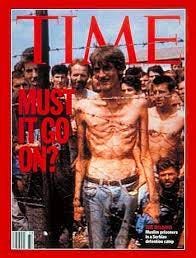In 1992, a photograph of Muslim Fikret Alic in a Bosnian concentration camp led to international outrage about the ongoing genocide in Bosnia. It took four more years before Western forces intervened. But libertarian critics from the left and right, in an effort to diminish the violence of ethnic cleansing by Bosnian Serbs, continue to argue that the picture distorted reality.
The image of Alic, filmed by an ITN British news team in a Bosnian Serb camp at Trnopolje in August 1992, became a worldwide symbol of the war in Bosnia. The picture invoked comparisons to the Holocaust and Margaret Bourke-Whites’ photographs from Buchenwald in 1945. The Daily Mirror, a British tabloid, ran the picture on its front page with the caption ‘Belsen 92.” It appeared on the covers of Newsweek and Time.
But German journalist Thomas Deichmann and others argued that image was misleading. According to Deichmann’s report in LM (formerly Living Marxism) titled “The Picture that Fooled the World,” Alic and his fellow Bosnian Muslims were not imprisoned and there was no barbed wire fence surrounding the Trnopolje camp. It was not a prison, and certainly not a 'concentration camp', but a collection center for refugees, many of whom went there seeking safety and could leave again if they wished, Deichmann claimed.
He wrote that the barbed wire in the picture was not around the Bosnian Muslims but around the cameraman and the journalists. It formed part of a broken-down barbed wire fence encircling a small compound that was next to Trnopolje camp. Deichmann reported that the British news team filmed from inside this compound, shooting pictures of the refugees and the camp through the compound fence. ITN sued and Deichmann and LM were found guilty of libel.
Deichmann and his magazine were concerned with what they saw as an anti-Serb bias in the Western media, according to an August 2010 article in the Journal of Human Rights. Deichmann had served as an expert witness for the defense of a Serbian charged with (and later convicted of) war crimes and was able to get access to the ITN reports. The Journal article notes:
· The claims of Deichmann and LM are erroneous and their arguments flawed. The major reason for this is the partial, selective and partisan manner in which they developed and presented their case. The journalists they criticized were not interviewed, and the inmates who survived the camps in the Prijedor region were ignored.
Others, including Noam Chomsky, saw the picture of Alic as an example of the demonization of the entire Serbian people by the Western media for the purposes of making US military intervention necessary and inevitable. “What matters for LM and others,” the Journal notes, “is the way this dispute enables the potential link between Bosnia and the Holocaust to be cut, the meaning of the Bosnian war to be diminished, and the responsibility of those who perpetrated the ethnic-cleansing campaigns to be denied…
“The banner of ‘historical revisionism’ is often a case of historical denial. This is not something that those who wish to question events like the Holocaust, genocide in Bosnia or genocide in Rwanda care to admit and actively resist.”
The article then cites historian Peter Novick in his work The Holocaust and Collective Memory (2000): “By making the Holocaust the emblematic atrocity, have we made resemblance to it the criterion by which we decide what horrors command our attention? Is the (quite unintended) result that horrors which don’t meet the criterion seem insufficiently dramatic, even a bit boring?”
LM’s talk of uniqueness and incomparability, the article notes, leads to what Novick calls “the evasion of moral and historical responsibility.” The Journal concludes:
· A renewed sense of intellectual responsibility is required if we are to understand and represent both the horrors of the Holocaust and those contemporary atrocities which seem to recall the worst excess of the past in the violence of the present.
Alic, who was portrayed in the photograph, recently joined a lawsuit against Serbian television misrepresentation of Serb atrocities. He now lives in Bosnia after a long stint in Copenhagen. He told El Pais:
· It is unfortunate to see that today some people make fun of our suffering and deny it, although personally I don’t pay too much attention to it, because I know what we lived through. This is not a matter of opinion, as our testimonies and the trials in British and Bosnia-Herzegovina courts confirmed. I think it would be good to punish the genocide deniers in order to look ahead to the future. And that requires a clear picture of what happened and means facing the truth.
Sources:
http://www.studiesinanti-capitalism.net/SIAC_ARTICLES_files/CAMPBELL%20LM%20part1.pdf


